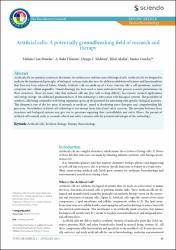| dc.contributor.author | Dundar, Mehmet Sait | |
| dc.contributor.author | Yildirim, A. Baki | |
| dc.contributor.author | Yildirim, Duygu T. | |
| dc.contributor.author | Akalin, Hilal | |
| dc.contributor.author | Dundar, Munis | |
| dc.date.accessioned | 2024-03-12T07:15:19Z | |
| dc.date.available | 2024-03-12T07:15:19Z | |
| dc.date.issued | 2024 | en_US |
| dc.identifier.issn | 2564-615X | |
| dc.identifier.uri | https://doi.org/10.2478/ebtj-2024-0006 | |
| dc.identifier.uri | https://hdl.handle.net/20.500.12573/1992 | |
| dc.description.abstract | Artificial cells are synthetic constructs that mimic the architecture and functions of biological cells. Artificial cells are designed to
replicate the fundamental principles of biological systems while also have the ability to exhibit novel features and functionalities
that have not been achieved before. Mainly, Artificial cells are made up of a basic structure like a cell membrane, nucleus,
cytoplasm and cellular organelles. Nanotechnology has been used to make substances that possess accurate performance in
these structures. There are many roles that artificial cells can play such as drug delivery, bio-sensors, medical applications
and energy storage. An additional prominent facet of this technology is interaction with biological systems. The possibility of
synthetic cells being compatible with living organisms opens up the potential for interfering with specific biological activities.
This element is one of the key areas of research in medicine, aimed at developing novel therapies and comprehending life
processes. Nevertheless, artificial cell technology is not exempt from ethical and safety concerns. The interplay between these
structures and biological systems may give rise to questions regarding their controllability and safety. Hence, the pursuit of
artificial cell research seeks to reconcile ethical and safety concerns with the potential advantages of this technology | en_US |
| dc.language.iso | eng | en_US |
| dc.publisher | Sciendo | en_US |
| dc.relation.isversionof | 10.2478/ebtj-2024-0006 | en_US |
| dc.rights | info:eu-repo/semantics/openAccess | en_US |
| dc.subject | Artificial Cells | en_US |
| dc.subject | Synthetic Biology | en_US |
| dc.subject | Therapy | en_US |
| dc.subject | Biotechnology | en_US |
| dc.title | Artificial cells: A potentially groundbreaking field of research and therapy | en_US |
| dc.type | article | en_US |
| dc.contributor.department | AGÜ, Mühendislik Fakültesi, Bilgisayar Mühendisliği Bölümü | en_US |
| dc.contributor.authorID | 0000-0002-0336-4825 | en_US |
| dc.contributor.institutionauthor | Dundar, Mehmet Sait | |
| dc.identifier.volume | 8 | en_US |
| dc.identifier.issue | 1 | en_US |
| dc.identifier.startpage | 55 | en_US |
| dc.identifier.endpage | 64 | en_US |
| dc.relation.journal | The EuroBiotech Journal | en_US |
| dc.relation.publicationcategory | Makale - Uluslararası Hakemli Dergi - Kurum Öğretim Elemanı | en_US |


















